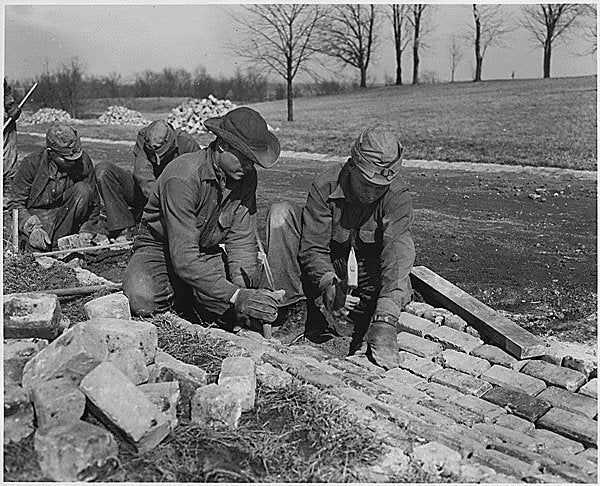
NEW YORK -- John Brennan turned 91 in May. Today he lives in relatively good health on Long Island, his mortgage paid off. When he was growing up in Manhattan during the Depression, though, times were tough.
"I was two weeks old when my father died, leaving my mother with five kids," he told HuffPost, his voice still marked by a craggy 1920s Hell's Kitchen accent. "Them days the women didn't have too much education, so my mother was out working most of the time, and we were free kids."
"She worked in all these different factories," he said. "Making candy, then a paint factory."
Under such desperate circumstances, Brennan himself had a hard time finding work during the Great Depression. So in 1937 he followed his older brother Peter into the Civilian Conservation Corps. He joined on his 17th birthday, the first day he was eligible.
The pay was only a dollar a day, but between 1933 and 1941, the program gave some 3 million young men employment. The CCC planted 3 billion trees, stemming the deforestation that caused the Dust Bowl, and built modest public works like park trails across the country.
As required by the program, Brennan sent $25 home a month, "which paid my mother's rent all the time." She was then able to use her extra money on other goods and services.
The experience of Brennan and those millions of other Americans who passed through the "alphabet soup" of New Deal agencies, from the WPA to the CWA to the PWA, may point to one possible solution for today's dragging economy: direct government employment on public works programs.
Joblessness increased from 3.3 percent in 1929 to 24.9 percent in 1933. For the millions out of work, President Franklin D. Roosevelt's New Deal jobs programs, like the CCC, offered hope in an otherwise bleak economic climate.
Today, as unemployment sits at 8.6 percent and the nation continues to muddle through its worst period of prolonged joblessness since the Great Depression, some economists and historians say we should look back to the New Deal's infrastructure programs to stem the crisis. President Obama pointed to that era on Tuesday in a fiery speech delivered in Osawatomie, Kans.
"This kind of inequality -- a level we haven't seen since the Great Depression -- hurts us all," Obama said.
Obama's speech comes at a time when the U.S.'s gross domestic product (GDP) rose at an annual rate of 2 percent in the third quarter of 2011 over the previous quarter. That modest economic boon, however, is not being shared widely.
Last year, economist Robert Shiller argued that Obama's Recovery Act erred in focusing on "GDP, not unemployment, which is perceived as a 'lagging indicator.'" Instead, he asked, "Why not use government policy to directly create jobs"?
"The basic idea makes good sense," said Dean Baker, co-director of the Center for Economic and Policy Research. "We have a lot of people that are unemployed. They aren't going to get picked up by the private sector. Why not have them try to do something productive?"
Economists are unanimous in agreeing that the New Deal itself did not end the depression -- it took World War II to do that. The programs Roosevelt instituted, said Baker, "did drastically reduce the unemployment rate ... but basically they weren't big enough."
Like the Recovery Act, the New Deal programs were seen as far too large by critical Republicans. The amounts spent on the WPA, for instance, were massive for their time: $1.4 billion in 1935, or 6.7 percent of GDP. But then came World War II, which cost $288 billion in 1940s dollars.
The war spurred massive spending on armaments and created millions of jobs in the armed services, sending unemployment down to 1 percent. When conservatives note that the New Deal didn't end the depression as evidence that Keynesian stimulus is ineffective, Baker isn't impressed.
"It seems kind of a strange complaint," he said. "I don't even know what these people think they're saying. If we call it a war it creates jobs, but if we don't it doesn't?"
Programs like the CCC and the Works Progress Administration worked very differently from most in 2009's Recovery Act. Instead of filtering money through contractors, government employment during the Depression was often truly direct, with the Treasury Department actually cutting checks. Participation in the programs was also often limited to people whose families had been registered on local relief rolls.
For Nick Taylor, who wrote "American Made: The Enduring Legacy of the WPA," the current moment of widespread unemployment means government programs have the ability to not only create jobs but also provide lasting public works benefits.
"The country had a 19th century infrastructure going into the 1930s," Taylor said. "And so the New Deal, not just the WPA, it extended electricity, it extended sanitary water supplies, it extended roads and bridges, it made transportation easier, it basically launched the era of civil aviation by building airports around the country."
In many cities and towns across the US, similar long-term effects of 1930s infrastructure investment linger, from the Bonneville Dam (immortalized in a song by Woody Guthrie) to the Triborough Bridge.
President Obama tried to make an argument about the short-term employment and long-term economic benefits of infrastructure investment with his American Jobs Act, but it was defeated by Congress in October.
Baker said the long-term argument wasn't even necessary for direct employment to be a good idea. His preference, he said, would be for programs that create green jobs and infrastructure, where "we get a real long-term benefit, it's not just make-work."
But at the same time, he said, "It makes sense just to have something like Civilian Conservation Corps where people just clean up parks, board up abandoned buildings ... a lot of that's not going to be particularly productive, but just to give people a chance."
Even the CCC, however, which relied on extremely low-skilled labor -- pick-axes, shovels and axes were about as high-tech as it got -- had lasting effects. Brennan remembers working on a dam at a CCC camp near Hyrum, Utah.
In 1993, he said, "I rode out to Utah, and I found the place. And I went up to the dam we built. Was still up there ... we had a big lake, and people in the vicinity were using it."
Given the way congressional Republicans throw around the word "stimulus" as if it were an epithet, and question whether the stimulus package had any effect at all on unemployment, anything like what Shiller proposed would be an incredibly tough sell in this political climate.
Jason Scott Smith, a historian who wrote "Building New Deal Liberalism: The Political Economy of Public Works, 1933-1956," said conservatives should remember that the New Deal public works programs relied in large part on local input to decide which programs to fund. Smith would like to see some type of revival of New Deal-like programs.
"This wasn't somehow Newt Gingrich's federal government reaching its tentacles into the states and the cities and telling them what to do," said Smith. "Someone there, the mayor or whoever, wanted these projects, whether they were Democrats or Republicans."
Perhaps the journey of John Brennan's brother, Peter, can offer an example of bipartisan cooperation for today. Decades after Peter's service in the CCC, he became a Democratic secretary of labor -- under Republican President Richard M. Nixon.
